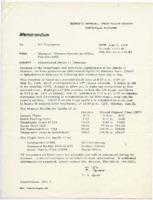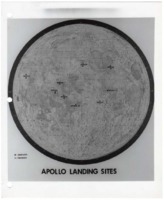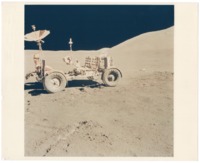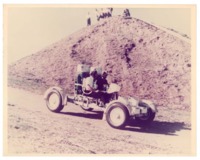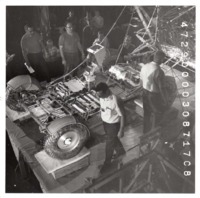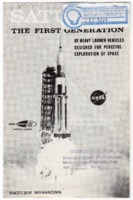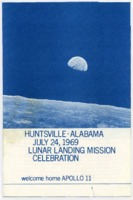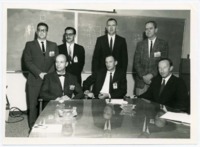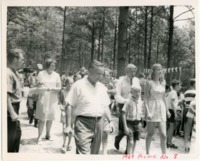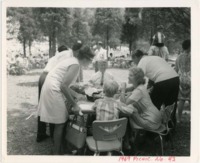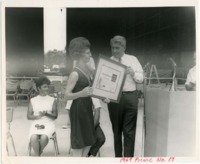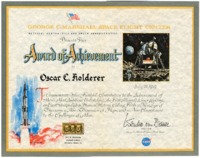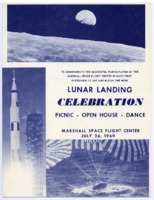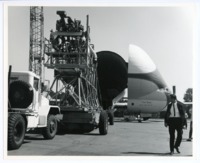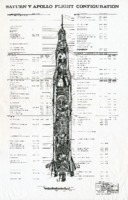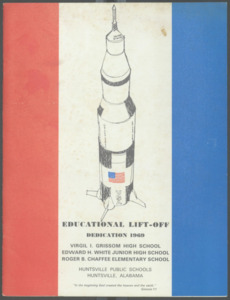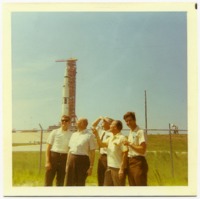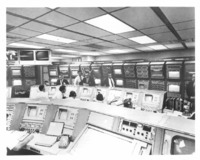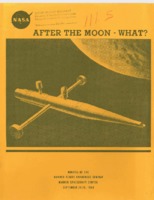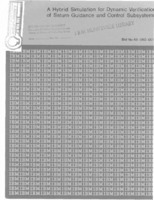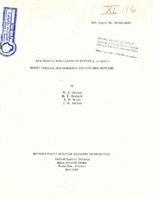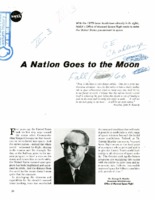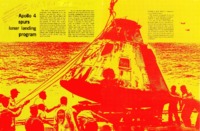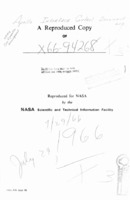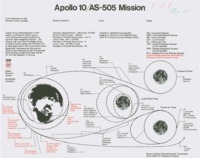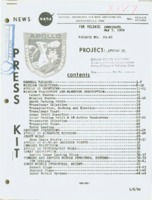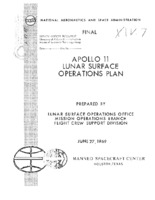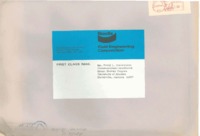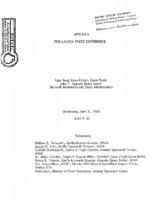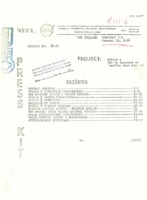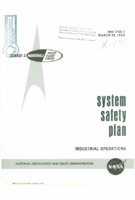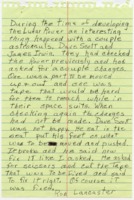
Browse Items (204 total)
Sort by:
-
Abbreviated timeline of the Apollo 11 mission.
The timeline includes a memorandum from Friedjof A. Speer, manager of the Missions Operations Office, to employees of Marshall Space Flight Center. Speer notes that "astronaut Neil Armstrong is scheduled to be the first man to step onto the moon's surface." The timeline outlines the entire mission from liftoff at 8:32 AM on Wednesday, July 16, 1969 to splashdown at 11:49 AM on Thursday, July 24, 1969. -
Map of completed and proposed Apollo moon landing sites.
The map shows landing locations on the moon's surface, including proposed landing sites of the cancelled Apollo 18 and Apollo 19 missions. This map was created as part of the Lunar Roving Vehicle (LRV) Project. -
The lunar roving vehicle (LRV) on the Moon.
This photo shows the LRV on the moon at the Hadley-Appenine mountain range landing site during the Apollo 15 mission. Developed by Marshall Space Flight Center and built by Boeing, the LRV was an electric vehicle used to explore the Moon's surface during the Apollo 15, 16, and 17 missions. -
Two astronauts driving a test model of the lunar roving vehicle (LRV).
Developed by Marshall Space Flight Center and built by Boeing, the LRV was an electric vehicle used to explore the Moon's surface during the Apollo 15, 16, and 17 missions. -
The lunar roving vehicle (LRV) during its construction.
Developed by Marshall Space Flight Center and built by Boeing, the LRV was an electric vehicle used to explore the Moon's surface during the Apollo 15, 16, and 17 missions. -
"Saturn I: The First Generation of Heavy Launch Vehicles Designed for Peaceful Exploration of Space."
The leaflet outlines the history of Saturn launches and gives a physical description of the rocket. The description includes a diagram of each stage; specifications of each stage's thrust, propellants, liftoff weight, and burning time; and engine specifications. -
Pamphlet from the Apollo 11 Lunar Landing Mission Celebration in Huntsville, Alabama.
The pamphlet includes biographical information on the three Apollo 11 astronauts as well as Wernher von Braun, then director of Marshall Space Flight Center. The back of the pamphlet congratulates the NASA and aerospace employees in Huntsville "who have made this historic achievement possible." -
"Steps to the Moon."
This flier highlights Marshall Space Flight Center's role in the lunar landing and illustrates each step of a successful mission, from liftoff at Kennedy Space Center to splashdown in the Pacific Ocean. -
The Apollo Lunar Surface Drill team at Marshall Space Flight Center.
John Bensko, Jr. is seated in the center of the front row. -
Wernher von Braun with daughter Margrit and son Peter in the crowd at the 1969 MSFC employee picnic.
MSFC Director of Administration and Technical Services David H. Newby is shown in the foreground. -
Wernher von Braun presents an Award of Achievement to Jean Drake at the 1969 MSFC employee picnic.
Drake worked in the Safety Office. Lois Smith is shown seated at left. -
Marshall Space Flight Center "Lunar Landing Celebration" program.
The celebration included an employee picnic, a dance, and an open house. -
"Saturn V Apollo Flight Configuration."
Drawn by Don Sprague at the Huntsville Engineering section of Boeing. -
"Educational Lift-Off: Dedication 1969."
The program dedicates three new Huntsville schools, each named for a member of the Apollo crew that died in the pad fire of February 21, 1967. This program was included in one of two scrapbooks that Christel and George McCanless made for UAH history professor Frances Roberts in 1969. -
Saturn V history team at the Apollo 10 launch.
Shown left to right: David Christensen, Melvin Kranzberg, Irving B. Holley, Jr., Rudolf Hermann, and Fred Ordway. -
"After the Moon - What? Minutes of the Manned Flight Awareness Seminar."
The seminar was held at the Manned Spacecraft Center, September 25-26, 1969. -
"A Hybrid Simulation for Dynamic Verification of Saturn Guidance and Control Subsystems."
This paper presents a discussion of a hybrid simulation used to dynamically verify the Saturn Guidance and Control subsystems. First, the Saturn vehicle is briefly described to provide background information. The Instrument Unit (IU) is considered in more detail to give a proper setting for the Guidance and Flight Control (G and FC) discussion that follows. After a brief description of the actual G and FC System operation, simulation models of the G and FC components are considered in detail. This is followed by a discussion of the model assignment to a particular computer (digital or analog) and justification for making that assignment. Finally, results of the AS-204/LM1 hybrid simulation studies are briefly considered with mention of the actual flight data. -
"All Digital Simulation of Saturn I, IB, and V: Boost Vehicle and Guidance Control Systems."
The introduction notes, "The Saturn V launch vehicle is being developed by the National Aeronautics and Space Administration's George C. Marshall Space Flight Center for Project Apollo; Saturn I and Saturn IB vehicles are providing the early testing and support for Project Apollo. The nerve center of the Saturn is its guidance and control system. An airborne digital computer provides the link which closes both the guidance and control loops,making verification of the flight computer program of vital importance. During a powered flight this onboard digital computer program can be divided into four major parts:a) guidance, including navigation, b) control, c) vehicle sequencing, and d) computer telemetry." -
"A Nation Goes to the Moon."
Written by NASA Office of Manned Space Flight Associate Administrator George E. Mueller, this is an article from G. E. Challenge, Fall 1966, page 26 to 32. -
Reproduction of "Apollo Interface Control Document Log."
This copy is a reproduction of a document held by the NASA Scientific and Technical Information Facility . -
Apollo 10/AS-505 mission chart.
The chart includes diagrams, mission statistics, crew, and notes. There is an additional copy in the David Christensen Collection. -
Apollo 10 press kit.
The press kit includes documentation on the Command and Service Module, Lunar Module, Saturn V launch vehicle, astronauts, and mission descriptions. Release No. 69-68. -
Final Apollo 11 Lunar Surface Operations Plan.
Prepared by the Lunar Surface Operations Office, Mission Operations Branch, Flight Crew Support Division. -
"Apollo 6 Pre-Launch Press Conference."
The press conference was given at Cape Royal News Center in Cocoa Beach, Florida, on Wednesday, April 3, 1968, at 3:30 PM. Participants: William C. Schneider, Apollo Mission Director, NASA; George M. Low, Apollo Spacecraft Manager, NASA; Clifford Charlesworth, Apollo 6 Flight Director, Manned Spacecraft Center, NASA; Dr. Arthur Rudolph, Saturn V Program Office, Marshall Space Flight Center, NASA; Rocco A. Petrone, Apollo 6 Launch Director, Kennedy Space Center, NASA; Col. Royce Olson, USAF, Director DOD Manned Spaceflight Support Office, Patrick AFB; Chris Kraft, Director of Flight Operations, Manned Spacecraft Center. -
"Apollo 7 Liftoff, Oct '68."
View from the spectator's gallery at Cape Canaveral as Apollo 7 launches. The film tracks the rocket from when the engines are ignited to when it disappears from view. Fall 1968. -
"Apollo 15 (Apollo 11 or 12?)."
Konrad Dannenberg goes to see one of the later Apollo flights liftoff from Cape Canaveral, Florida. This film contains a lot of shots of the spectator gallery as well as the lauch and disappearance of the Saturn V launching vehicle. 1969. -
"Daytona Beach - Apollo 15 - Traffic Jam."
The Dannenbergs travel down to Daytona Beach, Florida, to see the launch of Apollo 15. The first half shows the resort and Ingeborg sitting by the beach. The second half shows the drive to the launch facility in Cape Canaveral, Florida and the traffic they find upon arrival. 1971. -
"Apollo 15 Launch - Satellite model."
Konrad Dannenberg tours the visitor stand for the launch of Apollo 15. Of paticular note is a scale model the is on display showing a cross-section of the Skylab space station, as well as brief shots of the Saturn V launcher and the Vehicle Assembly Building. 1971. -
Apollo 5 press kit.
For release Thursday P.M., January 11, 1968. -
Apollo 15 launch footage.
First half of film shows the launch of Apollo 15 from Cape Canaveral. The second half shows three women, one of them Ingeborg Dannenberg, visiting a beach, probably near Cape Canaveral. 1971. -
"Apollo 16 Pre-launch, 4-23-72."
Ingeborg and Konrad get ready for the launch of Apollo 16. They are shown boarding a bus from their hotel in Cape Canaveral, Florida which conveys them to the visitor stands to watch the launch. While on the road to the stands, Konrad captures pictures of the vehicle assembly building and the rocket on the launchpad. Spring 1972. -
"4-23-72, Apollo 16 Launch."
The first half of the film shows Konrad Dannenberg surveying the stands for spectators of Apollo 16 at the launch complex in Cape Canaveral, Florida. The second half of the film follows the rocket as it lifts off from the launch pad and ascends out of view. Spring 1972. -
Ron Lancaster's handwritten notes recalling building the Lunar Roving Vehicle.
Ron Lancaster was an engineer for Boeing in Huntsville, Alabama. His handwritten notes describe encounters with astronauts Dave Scott and James Irwin, working with Grumman engineers at Kennedy Space Center, and going inside the Lunar Excursion Module.
